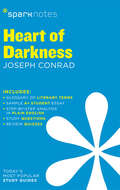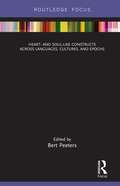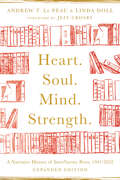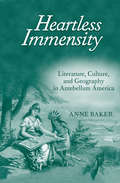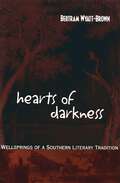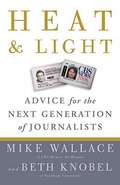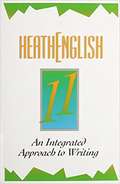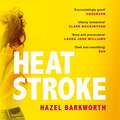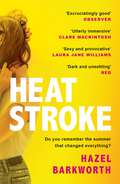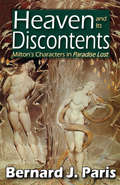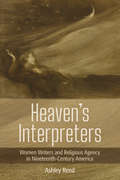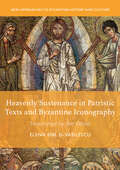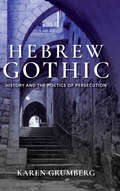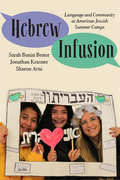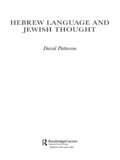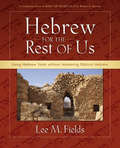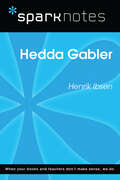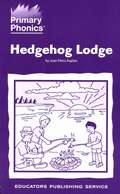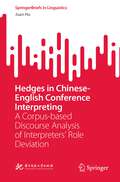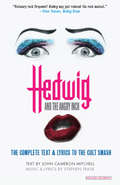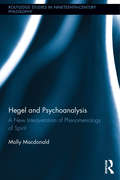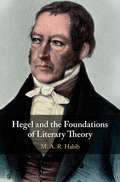- Table View
- List View
Heart of Darkness SparkNotes Literature Guide (SparkNotes Literature Guide Series #32)
by SparkNotesHeart of Darkness SparkNotes Literature Guide by Joseph Conrad Making the reading experience fun! When a paper is due, and dreaded exams loom, here's the lit-crit help students need to succeed! SparkNotes Literature Guides make studying smarter, better, and faster. They provide chapter-by-chapter analysis; explanations of key themes, motifs, and symbols; a review quiz; and essay topics. Lively and accessible, SparkNotes is perfect for late-night studying and paper writing. Includes:An A+ Essay—an actual literary essay written about the Spark-ed book—to show students how a paper should be written.16 pages devoted to writing a literary essay including: a glossary of literary termsStep-by-step tutoring on how to write a literary essayA feature on how not to plagiarize
Heart's Desire: Essays from Twenty Years
by Edward HoaglandThe essays vary in subject matter from "nature" essays to "city" essays.
Heart- and Soul-Like Constructs across Languages, Cultures, and Epochs (Routledge Studies in Linguistics)
by Bert PeetersAll languages and cultures appear to have one or more "mind-like" constructs that supplement the human body. Linguistic evidence suggests they all have a word for someone, and another word for body, but that doesn’t mean that whatever else makes up a human being (i.e. someone) apart from the body is the same everywhere. Nonetheless, the (Anglo) mind is often reified and thought of in universal terms. This volume adds to the literature that denounces such reification. It looks at Japanese, Longgu (an Oceanic language), Thai, and Old Norse-Icelandic, spelling out, in a culturally neutral Natural Semantic Metalanguage (NSM), how the "mind-like" constructs in these languages differ from the Anglo mind.
Heart. Soul. Mind. Strength.: A Narrative History of InterVarsity Press, 1947-2022
by Andrew T. Le Peau Linda Doll"Some publishers tell you what to believe. Other publishers tell you what you already believe. But InterVarsity Press helps you believe."J. I. PackerThe history of evangelicalism cannot be understood apart from the authors and books that shaped it. Over the past century, leading figures such as pastor-scholar John Stott, apologist James W. Sire, evangelist Rebecca Manley Pippert and spiritual formation writer Eugene Peterson helped generations of readers to think more biblically and engage the world around them. For many who take their Christianity seriously, books that equip them for a life of faith have frequently come from one influential publisher: InterVarsity Press.Andy Le Peau and Linda Doll provide a narrative history of InterVarsity Press, from its origins as the literature division of a campus ministry to its place as a prominent Christian publishing house. Here is a behind-the-scenes look at the stories, people, and events that made IVP what it is today. Recording good times and bad, celebrations and challenges, they place IVP in its historical context and demonstrate its contribution to the academy, church and world.In honor of IVP's seventy-fifth anniversary, senior editor Al Hsu has updated this edition with new content, bringing the story up to 2022 and including stories about contemporary authors such as Esau McCaulley and Tish Harrison Warren. As IVP continues to adapt to changes in publishing and the global context, the mission of publishing thoughtful Christian books has not changed. IVP stands as a model of integrative Christianity for the whole person—heart, soul, mind and strength.
Heartless Immensity: Literature, Culture, and Geography in Antebellum America
by Anne BakerAs the size of the United States more than doubled during the first half of the nineteenth century, a powerful current of anxiety ran alongside the well-documented optimism about national expansion. Heartless Immensity tells the story of how Americans made sense of their country's constantly fluctuating borders and its annexation of vast new territories. Anne Baker looks at a variety of sources, including letters, speeches, newspaper editorials, schoolbooks, as well as visual and literary works of art. These cultural artifacts suggest that the country's anxiety was fueled primarily by two concerns: fears about the size of the nation as a threat to democracy, and about the incorporation of nonwhite, non-Protestant regions. These fears had a consistent and influential presence until after the Civil War, functioning as vital catalysts for the explosion of literary creativity known as the "American Renaissance," including the work of Melville, Thoreau, and Fuller, among others. Building on extensive archival research as well as insights from cultural geographers and theorists of nationhood, Heartless Immensity demonstrates that national expansion had a far more complicated, multifaceted impact on antebellum American culture than has previously been recognized. Baker shows that Americans developed a variety of linguistic strategies for imagining the form of the United States and its position in relation to other geopolitical entities. Comparisons to European empires, biblical allusions, body politic metaphors, and metaphors derived from science all reflected--and often attempted to assuage--fears that the nation was becoming either monstrously large or else misshapen in ways that threatened cherished beliefs and national self-images. Heartless Immensity argues that, in order to understand the nation's shift from republic to empire and to understand American culture in a global context, it is first necessary to pay close attention to the processes by which the physical entity known as the United States came into being. This impressively thorough study will make a valuable contribution to the fields of American studies and literary studies.
Hearts of Darkness: Wellsprings of a Southern Literary Tradition (Walter Lynwood Fleming Lectures in Southern History)
by Bertram Wyatt-Brown?
Heat and Light: Advice for the Next Generation of Journalists
by Mike Wallace Beth KnobelPacked with practical wisdom, rubber-on-the-road tips, and never-before-heard anecdotes, this guide to creating good journalism is required reading for any aspiring reporter and editor.
Heath English: An Integrated Approach to Writing (Heath English)
by J. A. Senn Carol Ann SkinnerHeath English
Heatstroke: a dark, compulsive story of love and obsession
by Hazel Barkworth'Barkworth is excruciatingly good... An impressive first book' OBSERVER'A sultry, stifling debut exploring power, consent and womanhood' COSMOPOLITAN'The evocative one' HEAT magazine's READ OF THE WEEK'Read next if you loved Three Women by Lisa Taddeo' WHISTLES newsletter---Do you remember the summer that changed everything?Rachel and her daughter never had secrets. Until now.Lily is somewhere she shouldn't be. With someone she shouldn't be with.Mia misses her best friend. But she let her down.In the middle of a stifling heatwave, the three of them stand on the edge of irrevocable change. By the end, one burning question will remain... how could she let things go this far?FOR FANS OF ZOE HELLER, EMMA CLINE, EXPECTATION AND MY DARK VANESSA.---'I wanted to stay within its pages forever' CLARE MACKINTOSH'Stylish and sensual' KIRAN MILLWOOD HARGRAVE'A thrilling look at mothers and daughters, adolescence, sex, suburbia and secrets' NELL FRIZZELL'I am addicted... dark and twisty with beautiful, poetic writing' EMMA GANNON'Sexy and provocative' LAURA JANE WILLIAMS'Pulls you into its sweaty interior and keeps you gripped' RENEE KNIGHT'I couldn't tear myself away' ERIN KELLY'Compulsive, sticky and full of gorgeous writing' KIRSTIN INNES'Gripping and intensely atmospheric... you won't want to put this down' HEAT'A summer sizzler... with twists, turns and revelations in all the right places' EVENING STANDARD(P)2020 Headline Publishing Group Ltd
Heatstroke: a dark, compulsive story of love and obsession
by Hazel Barkworth'A thrilling look at mothers and daughters, adolescence, sex, suburbia and secrets' NELL FRIZZELL 'Unsettling, challenging and utterly immersive' CLARE MACKINTOSH'A sultry, stifling debut exploring power, consent and womanhood' COSMOPOLITAN ---In the middle of a stifling suburban heatwave, fifteen-year-old Lily doesn't come home one afternoon. Rachel is Lily's teacher. Her daughter Mia is Lily's best friend. When they learn that Lily meant to disappear, taking nothing but lipsticks and some lacy underwear from her mother's drawer, Rachel is horrified - like any other parent. But as Rachel becomes obsessed with Lily's secret life, and who she might be with, she grows increasingly distrustful of Mia. Rachel knows that her daughter is hiding something... because she is hiding something too.Unfolding over a stifling hot summer, Heatstroke draws us into the secrets, lies and betrayals that simmer beneath a fracturing relationship between mother and daughter, leaving them both changed forever.--- 'Barkworth is excruciatingly good' OBSERVER'I am addicted... dark and twisty with beautiful, poetic writing' EMMA GANNON 'Gripping and intensely atmospheric... you won't want to put this down' HEAT magazine's READ OF THE WEEK 'Stylish and sensual' KIRAN MILLWOOD HARGRAVE 'Twists, turns and revelations in all the right places' EVENING STANDARD'A stunning new voice... I couldn't tear myself away' ERIN KELLY 'Sexy and provocative' LAURA JANE WILLIAMS 'Pulls you into its sweaty interior and keeps you gripped' RENEE KNIGHT 'Compulsive, sticky and full of gorgeous writing' KIRSTIN INNES 'Read next if you loved Three Women by Lisa Taddeo' WHISTLES newsletter
Heatstroke: a dark, compulsive story of love and obsession
by Hazel Barkworth'A thrilling look at mothers and daughters, adolescence, sex, suburbia and secrets' NELL FRIZZELL 'Unsettling, challenging and utterly immersive' CLARE MACKINTOSH'A sultry, stifling debut exploring power, consent and womanhood' COSMOPOLITAN ---In the middle of a stifling suburban heatwave, fifteen-year-old Lily doesn't come home one afternoon. Rachel is Lily's teacher. Her daughter Mia is Lily's best friend. When they learn that Lily meant to disappear, taking nothing but lipsticks and some lacy underwear from her mother's drawer, Rachel is horrified - like any other parent. But as Rachel becomes obsessed with Lily's secret life, and who she might be with, she grows increasingly distrustful of Mia. Rachel knows that her daughter is hiding something... because she is hiding something too.Unfolding over a stifling hot summer, Heatstroke draws us into the secrets, lies and betrayals that simmer beneath a fracturing relationship between mother and daughter, leaving them both changed forever.--- 'Barkworth is excruciatingly good' OBSERVER'I am addicted... dark and twisty with beautiful, poetic writing' EMMA GANNON 'Gripping and intensely atmospheric... you won't want to put this down' HEAT magazine's READ OF THE WEEK 'Stylish and sensual' KIRAN MILLWOOD HARGRAVE 'Twists, turns and revelations in all the right places' EVENING STANDARD'A stunning new voice... I couldn't tear myself away' ERIN KELLY 'Sexy and provocative' LAURA JANE WILLIAMS 'Pulls you into its sweaty interior and keeps you gripped' RENEE KNIGHT 'Compulsive, sticky and full of gorgeous writing' KIRSTIN INNES 'Read next if you loved Three Women by Lisa Taddeo' WHISTLES newsletter
Heaven and Its Discontents: Milton's Characters in Paradise Lost
by Bernard J. ParisMany critics agree with C. S. Lewis that "Satan is the best drawn of Milton's characters". Satan is certainly a wonderful creation, but Adam and Eve are also complex and well-drawn, and God may be the most complicated character of all. Paradise Lost is above all God's story; it is his discontent, first with Lucifer and then with human beings, that drives the action from the beginning until his anger subsides at the world's end. God and Satan have similarities not only in their pursuit of revenge, but also in their craving for power and glory. The ambitious Satan wants more than he already has, but what accounts for the voracity of God's appetite? Does the fact that each threatens the status of the other help to explain the intensity of their hatred and rage? Is their vindictiveness a response to being threatened, an effort to repair the injury they feel they've sustained? This seems to be the case for Satan, but must not God also have felt deeply hurt to have such a powerful need for vengeance? If so, why is the Almighty so vulnerable? And why is he so hard on Adam and Eve and the rest of humankind? These are the kinds of questions Bernard Paris tries to answer in this book. Paris's purpose is not to focus on Milton's illustrative intentions but to try to understand God, Satan, Adam, and Eve as psychologically motivated characters who are torn by inner conflicts.Most critics treat Milton's characters as coded messages from the author, but their mimetic features interfere with the process of decoding. Instead of looking through the characters to the author, Paris looks at Milton's characters as objects of interest in themselves, as creations inside a creation who escape their thematic roles and are embodiments of his psychological intuitions. This book heightens our appreciation of an ignored aspect of Milton's art and offers new insights into the critical controversies that have surrounded Paradise Lost.
Heaven's Interpreters: Women Writers and Religious Agency in Nineteenth-Century America
by Ashley ReedIn Heaven's Interpreters, Ashley Reed reveals how nineteenth-century American women writers transformed the public sphere by using the imaginative power of fiction to craft new models of religious identity and agency. Women writers of the antebellum period, Reed contends, embraced theological concepts to gain access to the literary sphere, challenging the notion that theological discourse was exclusively oppressive and served to deny women their own voice. Attending to modes of being and believing in works by Augusta Jane Evans, Harriet Jacobs, Catharine Maria Sedgwick, Elizabeth Oakes Smith, Elizabeth Stoddard, Harriet Beecher Stowe, and Susan Warner, Reed illuminates how these writers infused the secular space of fiction with religious ideas and debates, imagining new possibilities for women's individual agency and collective action.Thanks to generous funding from Virginia Tech and its participation in TOME (Toward an Open Monograph Ecosystem), the ebook editions of this book are available as Open Access volumes from Cornell Open (cornellopen.org) and other repositories.
Heavenly Sustenance in Patristic Texts and Byzantine Iconography: Nourished by the Word (New Approaches to Byzantine History and Culture)
by Elena Ene D-VasilescuThis book examines ideas of spiritual nourishment as maintained chiefly by Patristic theologians –those who lived in Byzantium. It shows how a particular type of Byzantine frescoes and icons illustrated the views of Patristic thinkers on the connections between the heavenly and the earthly worlds. The author explores the occurrence, and geographical distribution, of this new type of iconography that manifested itself in representations concerned with the human body, and argues that these were a reaction to docetist ideas. The volume also investigates the diffusion of saints’ cults and demonstrates that this took place on a North-South axis as their veneration began in Byzantium and gradually reached the northern part of Europe, and eventually the entirety of Christendom.
Hebrew Gothic: History and the Poetics of Persecution (Jewish Literature And Culture Ser.)
by Karen Grumberg&“Makes a persuasive argument&” that gothic ideas &“play a vital role in how Hebrew writers have confronted history, culture, and politics.&” —Robert Alter, author of Hebrew and Modernity Sinister tales written since the early twentieth century by the foremost Hebrew authors, including S.Y. Agnon, Leah Goldberg, and Amos Oz, reveal a darkness at the foundation of Hebrew culture. The ghosts of a murdered Talmud scholar and his kidnapped bride rise from their graves for a nocturnal dance of death; a girl hidden by a count in a secret chamber of an Eastern European castle emerges to find that, unbeknownst to her, World War II ended years earlier; a man recounts the act of incest that would shape a trajectory of personal and national history. Reading these works together with central British and American gothic texts, Karen Grumberg illustrates that modern Hebrew literature has regularly appropriated key gothic ideas to help conceptualize the Jewish relationship to the past and, more broadly, to time. She explores why these authors were drawn to the gothic, originally a European mode associated with antisemitism, and how they use it to challenge assumptions about power and powerlessness, vulnerability and violence, and to shape modern Hebrew culture. Grumberg provides an original perspective on Hebrew literary engagement with history and sheds new light on the tensions that continue to characterize contemporary Israeli cultural and political rhetoric.
Hebrew Infusion: Language and Community at American Jewish Summer Camps
by Sarah Bunin Benor Jonathan Krasner Sharon AvniEach summer, tens of thousands of American Jews attend residential camps, where they may see Hebrew signs, sing and dance to Hebrew songs, and hear a camp-specific hybrid language register called Camp Hebraized English, as in: “Let’s hear some ruach (spirit) in this chadar ochel (dining hall)!” Using historical and sociolinguistic methods, this book explains how camp directors and staff came to infuse Hebrew in creative ways and how their rationales and practices have evolved from the early 20th century to today. Some Jewish leaders worry that Camp Hebraized English impedes Hebrew acquisition, while others recognize its power to strengthen campers’ bonds with Israel, Judaism, and the Jewish people. Hebrew Infusion explores these conflicting ideologies, showing how hybrid language can serve a formative role in fostering religious, diasporic communities. The insightful analysis and engaging descriptions of camp life will appeal to anyone interested in language, education, or American Jewish culture.
Hebrew Language and Jewish Thought (Routledge Jewish Studies Series)
by David PattersonDrawing on more than three hundred Hebrew roots, the author shows that Jewish thought employs Hebrew concepts and categories that are altogether distinct from those that characterize the Western speculative tradition. Among the key categories that shape Jewish thought are holiness, divinity, humanity, prayer, responsibility, exile, dwelling, gratitude, and language itself. While the Hebrew language is central to the investigation, the reader need not have a knowledge of Hebrew in order to follow it. Essential reading for students and scholars of Judaism, this book will also be of value to anyone interested in the categories of thinking that form humanity's ultimate concerns.
Hebrew for the Rest of Us: Using Hebrew Tools without Mastering Biblical Hebrew
by Lee M. FieldsThis is a companion volume to Greek for the Rest of Us by William D. Mounce. This book is a guide for English-only readers to understand the language of the Old Testament just enough to work with the Old Testament in more detail and to understand the scholarly literature on the Hebrew Bible. Its specific aims are to aid students to learn (1) why translations differ, (2) how to do Hebrew word studies, (3) what the basics of Hebrew exegesis are, and (4) how to read more advanced Old Testament commentaries with greater understanding. Herbrew for the Rest of Us is set up in a workbook format.
Hedda Gabler (SparkNotes Literature Guide Series)
by SparkNotesHedda Gabler (SparkNotes Literature Guide) by Henrik Ibsen Making the reading experience fun! Created by Harvard students for students everywhere, SparkNotes is a new breed of study guide: smarter, better, faster.Geared to what today's students need to know, SparkNotes provides:chapter-by-chapter analysis explanations of key themes, motifs, and symbols a review quiz and essay topics Lively and accessible, these guides are perfect for late-night studying and writing papers.
Hedges in Chinese-English Conference Interpreting: A Corpus-based Discourse Analysis of Interpreters’ Role Deviation (SpringerBriefs in Linguistics)
by Juan HuThis book explored interpreters’ role when interpreting for Chinese government press conference and discovered the role deviation of conference interpreters in Chinese–English conference interpreting, by taking corpus-based approach to analyze hedges in interpreting discourse. So far, the discovery of role deviation for conference interpreters in this book is relevantly fresh in conceptual, empirical, and methodological aspects, against the background that conference interpreters are traditionally assumed to be invisible and passive “non-person.” Arguably, this book revisited and renewed the concept of interpreters’ role, offered a role theory-based theoretical framework in some potential issues in future studies, designed a novel empirical route by using hedges as the intervening points to gain insight into interpreters’ role, and applied Python-a new natural language processing programming in data extraction. Thus, this book is believed to contribute some new conceptual, theoretical as well as methodological significance to the future studies on interpreters’ role and performance. This book is intended to act as a useful reference for scholars, practitioners, interpreters, graduate and advanced undergraduate students, and anyone who shows interest in interpreters’ role and performance, corpus-based interpreting product.
Hedwig and the Angry Inch
by John Cameron Mitchell Stephen TraskOn Valentine’s Day 1998, Hedwig and the Angry Inch opened off-Broadway to rave reviews, revitalizing the rock musical while engendering a die-hard cult following, and the phenomenon of Hedwig was born. In 2001, the mesmerizing film adaptation was released to equally glowing reviews. Brilliantly innovative and oddly endearing, Hedwig and the Angry Inch-inspired by Plato’s Symposium-is the story of "internationally ignored song stylist” Hedwig Schmidt, the victim of a gruesomely botched sex-change operation, as dazzlingly recounted by Hedwig (née Hansel) herself in the form of a lounge act, backed by the rock band The Angry Inch. .
Hegel and Psychoanalysis: A New Interpretation of "Phenomenology of Spirit" (Routledge Studies in Nineteenth-Century Philosophy)
by Molly MacdonaldBoth Hegel's philosophy and psychoanalytic theory have profoundly influenced contemporary thought, but they are traditionally seen to work in separate rather than intersecting universes. This book offers a new interpretation of Hegel's Phenomenology of Spirit and brings it into conversation the work of two of the best-known contemporary psychoanalysts, Christopher Bollas and André Green. Hegel and Psychoanalysis centers a consideration of the Phenomenology on the figure of the Unhappy Consciousness and the concept of Force, two areas that are often overlooked by studies which focus on the master/slave dialectic. This book offers reasons for why now, more than ever, we need to recognize how concepts of intersubjectivity, Force, the Third, and binding are essential to an understanding of our modern world. Such concepts can allow for an interrogation of what can be seen as the profoundly false and constructed senses of community and friendship created by social networking sites, and further an idea of a "global community," which thrives at the expense of authentic intersubjective relations.
Hegel and the Foundations of Literary Theory
by M. R. HabibDo the various forms of literary theory – deconstruction, Marxism, new historicism, feminism, post-colonialism, and cultural/digital studies – have anything in common? If so, what are the fundamental principles of theory? What is its ideological orientation? Can it still be of use to us in understanding basic intellectual and ethical dilemmas of our time? These questions continue to perplex both students and teachers of literary theory. Habib finds the answers in theory's largely unacknowledged roots in the thought of German philosopher Hegel. Hegel's insights continue to frame the very terms of theory to this day. Habib explains Hegel's complex ideas and how they have percolated through the intellectual history of the last century. This book will interest teachers and students of literature, literary theory and the history of ideas, illuminating how our modern world came into being, and how we can better understand the salient issues of our own time.
Hegel on Philosophy in History
by Rachel Zuckert James KreinesIn this volume honouring Robert Pippin, prominent philosophers such as John McDowell, Slavoj Žižek, Jonathan Lear, and Axel Honneth explore Hegel's proposals concerning the historical character of philosophy. Hegelian doctrines discussed include the purported end of art, Hegel's view of human history, including the history of philosophy as the history of freedom (or autonomy), and the nature of self-consciousness as realized in narrative or in action. Hegel scholars Rolf-Peter Horstmann, Sally Sedgwick, Terry Pinkard, and Paul Redding attempt to vindicate some of Hegel's claims concerning historical philosophical progress, while others such as Robert Stern, Christoph Menke, and Jay Bernstein suggest that Hegel either did not conceive of philosophy as progressing unidirectionally or did not make good on his claims to progress: perhaps we should still be Aristotelians in ethics, or perhaps we are still torn between sensibility and reason, or between individuality and social norms. Perhaps capitalism has exacerbated such problems.
